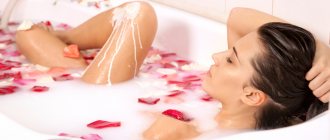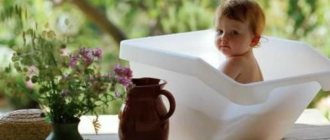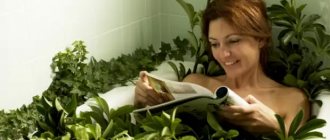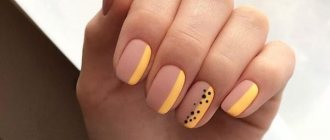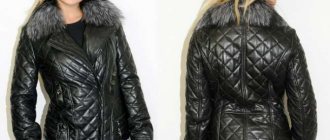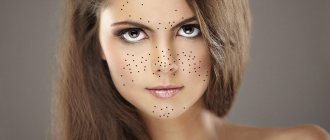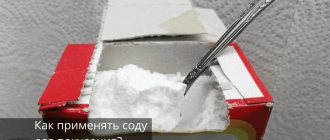No woman would refuse to take a bubble bath after a hard day at work. It has a relaxing and calming effect on the body, helping to cope with fatigue and anxiety. You can choose a bath foam with a floral, pine or any other scent. The choice in stores is simply huge. For those who do not like the composition of such a bath product, we can recommend making the foam yourself. To do this, you will need simple ingredients that are probably available in every home.
Beneficial properties of a bubble bath
Foam is a liquid, solid or gel cosmetic product that is added to water during bathing. It makes water procedures more useful and enjoyable. Foam bath:
helps to relax and calm down or, conversely, activate vitality; promotes deep cleansing of the skin and opens pores; nourishes and moisturizes; accelerates metabolism.
High-quality foam contains mineral salts, natural plant ingredients, essential oils, foaming agents, etc.
Why is foam needed?
The bubble bath procedure is not only enjoyable, but also necessary. For example, foam does a better job of cleansing the skin than other products. The surface of the dermis absorbs nutrients better. A foam bath promotes relaxation, distracts you from the hustle and bustle of the day, and puts you in a positive mood. Manufacturers do not skimp on additives such as essential oils, flavors, and plant extracts. A bubble bath won't hurt if:
- After a working day, it is necessary to relieve fatigue;
- the skin needs nourishing hydration;
- the body needs warming up and protection from colds;
- the body is prescribed a course of aromatherapy.
The optimal composition of the product must be taken into account depending on the specific purpose. The products have a relaxing or invigorating effect. There are tonic options with moisturizing substances in the composition. Essential oils, mineral salts, fruit or plant extracts are all also foam components.
What types of bath foams are there?
There are the following types of bath foam:
sea - foam with the smell of the sea. The composition of such cosmetic products often includes sea salt, which has an anti-inflammatory and antiseptic effect on the skin; floral, plant - contains extracts of medicinal plants. A foam bath with the addition of chamomile extract will soothe sensitive skin, and with tea tree oil it will dry out inflammation and acne, etc. coniferous - contains essential oils of coniferous plants and trees (fir, spruce, juniper). This bath calms and relaxes, helps to cope with insomnia; citrus, fruit - with notes of lemon, orange, apple, mango, etc.; honey, vanilla, chocolate and others.
What is bubble bath?
In recent times, bubble baths were produced only in liquid consistency, like shampoo or gel. Currently, bath foams are produced in the form of figures, bombs, salts, etc. However, what unites them is their composition. It contains essential oil, foaming agent, natural plant extracts, mineral salt. The choice of bath foam depends only on your taste.
Classification of bath foams:
Conifers
Coniferous bath foams contain the scent of spruce, juniper, fir, and pine. They may contain both natural essential oils of coniferous trees and their substitutes. The color of coniferous foams is usually greenish. It is recommended to use foams of this category before bedtime. They will refresh your body and help relieve tension and fatigue. Taking a bath with pine foam is similar in effectiveness to taking a pine bath.
Marine
“Sea” bath foams are characterized by the fresh smell of the sea and colors: blue, blue, blue-green. Sometimes they contain sea salt, which has a beneficial effect on the body. Sea salt has a tonic effect, gives vitality, is an anti-inflammatory agent, and relieves skin from flaking and dryness. An analogue of such a foam bath is a bath with sea salt.
Coniferous and “marine” scents, due to their unobtrusive scent, are popular with both men and women.
Fruit
Fruit bath foams are characterized by the presence of fruit extracts in their composition. Citrus foams are popular among fruit bath foams. They help improve blood circulation, refresh and strengthen the skin. Bath foam, which includes grapefruit essential oil, has antioxidant properties. By using citrus foam, you rid the skin of toxins and swelling, improve the metabolic process in the body's cells.
Among fruit bath foams, there are foams with extracts of peach, strawberry, apple, watermelon, kiwi, mango, and melon. They provide a softening and tonic effect, relieve irritability, and relieve fatigue. Fruit scents have only recently appeared on the market, but have already gained great popularity, especially among the fair half of humanity.
Bath foam with extracts of medicinal flowers and herbs
This category of foams is distinguished by a variety of odors. They contain extracts of mint, chamomile, and string, which help relieve swelling, skin irritation, and cleanse the respiratory tract. Their use is especially useful for colds. This category includes foam with tea tree extract. It has anti-inflammatory properties. Foam with extracts of sandalwood, rose, aloe vera perfectly moisturizes the skin, making it soft and velvety.
Edible bubble baths
Recently, the smells of caramel, honey, vanilla, cocoa, chocolate, and liqueur have become very fashionable. Both adults and children like these foams.
How to prepare a bubble bath
You can prepare a bubble bath in the following sequence:
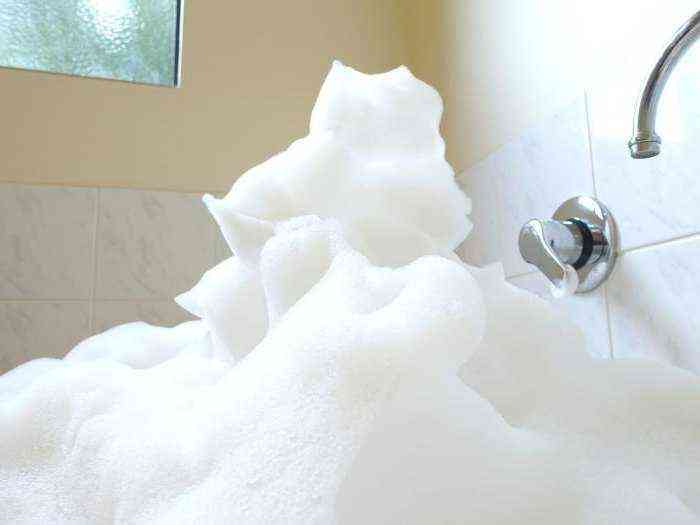
Open the tap, adjust the water temperature and close the drain hole. Measure out the required amount of foam. For a home remedy, 60 ml will be enough, for store-bought foam - as much as indicated on the bottle. Pour the required amount of product into a small container. Pour the foam directly under running water. After some time, a large number of bubbles should form in the bath. A bubble bath will remain warm longer if there is a lot of water. To form more bubbles, it is recommended to shake the foam additionally with your hands. Now you can immerse yourself in the water for 20-30 minutes, turning on relaxing music.
Egg white bubble bath
This is one of the easiest options for making bubble bath at home. It is made on the basis of liquid soap with the addition of additional ingredients:
honey, which has a moisturizing effect on the skin; egg white, thanks to which the bubbles keep their shape longer and the foam does not settle; essential oil for relaxing or tonic aromatherapy.
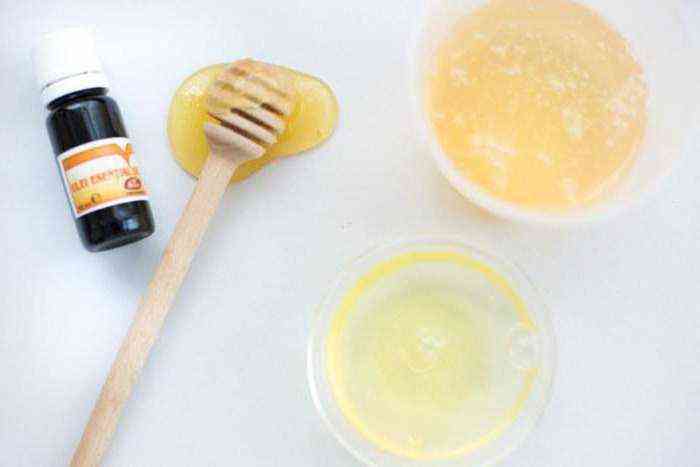
You can use absolutely any liquid soap for the recipe, traditional or Castilian - natural, plant-based. However, if you plan to add essential oil to the foam, it is recommended to use unscented soap.
All that remains is to figure out how to make bubble bath. To prepare the product, you need to combine soap (110 ml or 1/2 tbsp), egg white, honey (1 tbsp), essential oil of lavender, chamomile, etc. (5 drops) in a glass or ceramic bowl. Those with dry skin can add any vegetable oil, such as olive or almond, to the composition, which is necessary to soften the skin.
When preparing the foam, do not beat the ingredients, but mix them carefully so that the mass does not start to foam. It is recommended to store homemade bath foam in the refrigerator, since the product contains natural egg white. The shelf life of the foam is 7 days. From the presented amount of ingredients you can prepare foam for taking two baths.
Properties of bath foam
The right bath foam will help you relax, relieve stress, restore health and cope with insomnia. In addition, foam with a neutral alkaline composition protects the skin from drying out, making it soft and silky.
Bath foam has a beneficial effect on the skin and the body as a whole thanks to the beneficial components contained in its composition, aromatizes the room and can even act as aromatherapy if it contains essential oils.
Foam bath: photo, recipe
For anyone who does not want to add egg whites to their bubble bath, we can recommend the following recipe. This preparation option involves the use of glycerin, which can be purchased at the pharmacy.
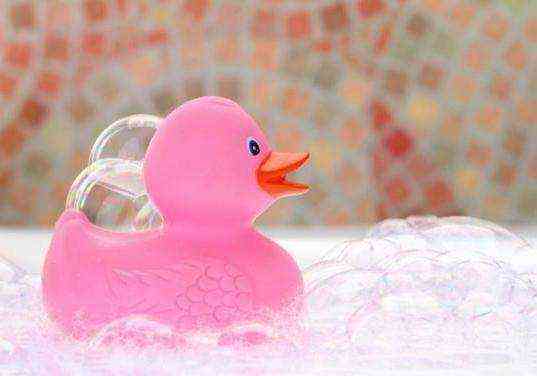
Bath foam at home according to this recipe is prepared as follows:
Liquid soap (170 ml) is poured into a ceramic or glass bowl. It is advisable to choose natural Castile soap based on herbal ingredients. Add glycerin (1 tablespoon) into a bowl of soap. Add a little liquid honey or sugar (1 teaspoon). If desired, add 5 drops of essential oil. Gently mix the ingredients so that the soap has not started to foam. Pour the finished foam into a glass jar with a lid or a small plastic bottle. Since natural ingredients can form sediment at the bottom of the storage container, they should be shaken before use, and then poured under running water.
Using this amount of ingredients you can make a bubble bath for three uses. You can store it directly on the shelf in the bathroom, and you need to use it within two weeks.
Bath foam: reviews, tips and contraindications
Almost all major manufacturers of cosmetics, along with shampoos, produce bath foam. In their reviews of these products, buyers note how strongly or weakly they are scented, how well they foam, and whether they color the water.

As for homemade foam, the following reviews can be highlighted:
homemade bath product foams less than store-bought one. Store-bought foam contains surfactants that form a large number of bubbles when in contact with water; homemade foam does not dry out the skin, but, on the contrary, moisturizes it; if scented liquid soap is used as a base, you should not add essential oils to the foam. Otherwise, you may end up with a product with an unpleasant odor.
Before taking a bubble bath, it is recommended to turn off the lights and light candles. An additional relaxing effect can be obtained by listening to music or reading a book while taking a bath. Upon completion of the procedure, it is recommended to moisturize the body with a special cream or lotion.
A foam bath also has a number of contraindications. It is not recommended to take it for more than half an hour, as it dries out the skin very much, and also for pregnant women to avoid complications.
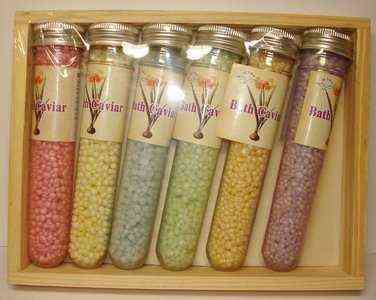
Many people like to take a bubble bath, but in order for the procedure to be not only pleasant, but also useful, the bubble bath must be prepared correctly.
There are many recipes for preparing bath foam, including tonic and invigorating, relaxing and moisturizing, vitamin and satiating, and therefore, if you are interested in learning a little more about this procedure, we suggest you familiarize yourself with specially prepared material.
Types of bubble bath
Usually, when we talk about bath foam, we mean a thick liquid that gradually mixes with water and fills the room with a subtle aroma. Today, foams are available in various forms: in the form of soluble figures, bombs, balls and much more.
The type of bath foam depends on the form of its release, the smell and the age for which it is intended. For children, special bath foams with a hypoallergenic composition are produced; they are suitable for delicate children's skin, do not sting the eyes, and sometimes are even edible. A real holiday for a child!
Bath foams come in both natural and synthesized extracts. Of course, natural ones are preferable, but their cost is noticeably more expensive than artificial substitutes. We recommend that you carefully study the composition before purchasing foam: some additives are harmless, while others may cause allergies and irritation.
The variety of scents allows you not only to choose your favorite, but also to choose foam with certain properties: relaxing, invigorating or healing.
The main types of bath foam depending on the aromas:
- Coniferous foam with aromas of spruce, fir, pine.
- Sea foam / based on sea salt.
- Foam with floral extracts of rose, lavender, jasmine and other flowers.
- Foam with extracts of medicinal herbs and plants such as tea tree and aloe vera.
- Fruity foam with aromas of citrus, peaches, apples and even watermelon.
Classification of bath foam
Each of us remembers not so long ago the standard bubble bath was on sale - a pretty color and pleasant aroma liquid in bottles and bubbles. But modern bath foams can look a little different, representing the special salts, cute figures and bath bombs that we talked about earlier. But what unites them all is their special composition - essential oil, mineral salts, extracts of various natural plants and fruits, as well as the foaming agent itself. What are the different classes of bath foams these days?
Sea foam baths
Sea foams are characterized by a specific aroma and color, special consistency and even granules or bubbles, which are often included in the composition. This is foam of blue, azure, green, blue and other colors, which smells of freshness, sea breeze, and other aromas characteristic of the sea. Quite often, such foam includes sea salt, which has a beneficial effect on the body as a whole, and the skin in particular. It tones, invigorates, tightens the skin, and has some anti-inflammatory effect.
Coniferous bath foams
Pine baths are recommended before bed, as they have a relaxing and calming effect. Quite often, such foam contains extracts or substitutes with the aroma of pine, fir, juniper, and pine. Coniferous foam has not only an interesting, natural smell, but also a pleasant color - green or its shades.
Fruit bath bubbles
The effect of fruit foam is a little similar to taking a fruit bath itself, since the special substances contain fresh fruit extract, which saturates the foam with aroma and color. Yellow, red, greenish, purple foam with the aroma of mango, lemon, watermelon and other fruits and citruses will strengthen and heal the skin, refresh and improve blood circulation. Many therapeutic foams made with high-quality extracts and oils can even make the skin more elastic and remove toxins from it that are retained in the pores.
When choosing a fruit bath foam, be sure to pay attention to the instructions for use and study the effect of the foam on the body, perhaps you will be able to choose the most optimal foam with the effect on the skin and general condition that you need individually.
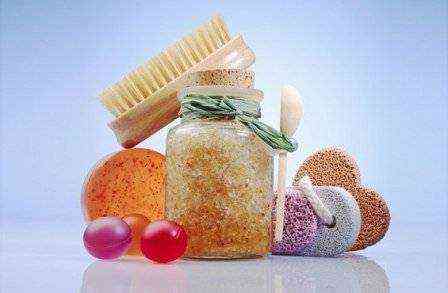
Medicinal bubble bath
We cannot say that this type of foam is the most popular, but it is quite in demand, since the extract of string, mint, chamomile and other wonderful plants with a medicinal effect can have the most positive effect on the body. Skin hydration, relaxation, calming, anti-inflammatory effects, toning and invigorating effects - all this can be combined with the truly beneficial properties of foam from quality manufacturers who present their products on the cosmetic market.
Baby bubble bath
A special class of foam that you should pay close attention to, especially if you want to choose the optimal composition and aroma for the bath that your baby will take. Here, first of all, you should worry not about color and aroma, but about the naturalness of production and only those components that can have a positive, but not a negative effect.
Edible bubble bath
To tell the truth, this is an indirect or contrived name that many buyers are now using. This kind of foam is so cute and aromatic that you really want to eat it. Just imagine a bubble bath with the scent of chocolate, vanilla, honey or caramel... we are sure that absolutely everyone will like this bubble bath.
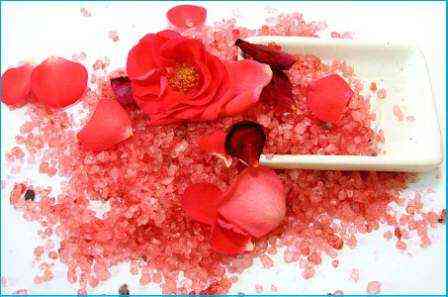
What is bubble bath used for?
Ekaterina Berezkina @berezkina
2018-11-09 00:15 post
Taking a bubble bath is not only pleasant, but also useful. This water procedure perfectly cleanses the skin and prepares it for the application of nourishing products, helps you relax, take your mind off the daily hustle and bustle and tune in to a positive wave. The benefits of using bath foam are provided by the plant extracts, essential oils and other nutrients included in the product. @stenders
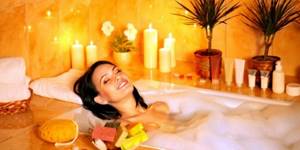
The main reasons for taking a bubble bath are:
the desire to pamper yourself after a working day, to relieve fatigue and tension; the skin’s need for hydration and nutrition - these are provided by the beneficial components included in the foam; the need to warm up and protect the body during colds; the ability to combine water procedures with a course of aromatherapy. Varieties of bath foam
Its optimal composition depends on why bath foam is needed in a particular case. Such products come with a relaxing or invigorating effect, tonic and moisturizing components, a variety of essential oils, mineral salts, fruit and plant extracts. The main types of bath foam are shown in the table:
Category of funds
Their features
Fruit, berry
The composition of such products includes extracts of fruits or berries: pomegranate, grapefruit, cranberry, etc. They saturate the product with color and aroma, and also have a beneficial effect on the condition of the skin: they refresh and strengthen it, improve blood circulation, and promote the elimination of toxins.
Floral
Products with the scent of rose, lavender, peony and other flowers. In addition to the luxurious smell, they have a useful composition with natural oils and extracts of medicinal plants.
Conifers
Products with a calming and relaxing effect. They contain essential oils of coniferous plants: pine, fir, juniper. They produce a tonic effect and help strengthen the immune system during colds.
Medicinal, herbal
Cosmetic products containing extracts of chamomile, linden, string and other medicinal plants. They have a beneficial effect on the skin and the entire body.
Combined
Products with a combination of essential oils, plant or fruit extracts and other beneficial components. For example, the 24-karat gold bath elixir contains pomegranate extract and tiny particles of 24-karat gold.
In addition to liquid bath foam, an original alternative to this product is on sale - oil bubbling balls or “bombs”. They contain sea salt, vegetable and essential oils. Sometimes such cosmetic products additionally contain tiny particles of luffa, milk, coffee, plant extracts and other valuable components.
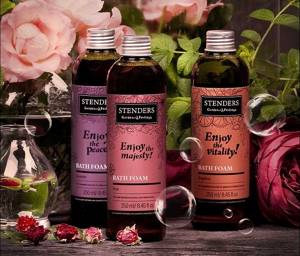
How to use bubble bath?
Using such tools is very simple. Liquid foam must be collected in a cap and placed under running water. The product in the form of salt, bath milk or a bubbling ball just needs to be dissolved in water. Its optimal temperature is 37–38°C. It is better to immerse yourself in water gradually: first place your legs, then your back and the rest of the body. The duration of the procedure is 10–20 minutes.
The best time to take a bubble bath is in the evening, before bed. After taking a bath, it is recommended to pat your skin dry with a soft towel and apply a product for further body care - cream, yogurt, milk, lotion or oil. Once it's absorbed, it's best to lie down and rest, especially if you used a relaxing foam.
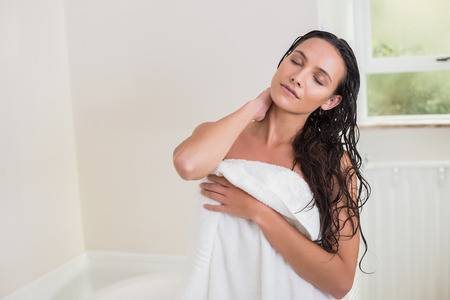
Contraindications for taking bubble baths
People with: epilepsy should avoid taking a bubble bath;
tuberculosis; liver cirrhosis; diabetes; severe angina or hypertension; atherosclerosis; cardiovascular failure; oncological diseases.
These contraindications are relevant for taking any general baths. In other cases, to exclude allergic reactions and other negative consequences, it is necessary to take into account the individual characteristics of the body. For example, products with mint or eucalyptus extract are contraindicated for people with cardiovascular disorders. If you are allergic to citrus oils or other ingredients, it is important to choose cosmetics that do not contain them.
Taking a bath can be harmful if you use a low-quality product based on synthetic ingredients or exceed the recommended water temperature.
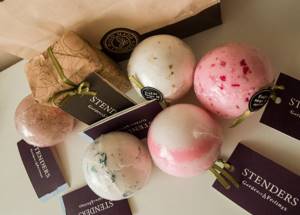
Recommendations for choosing bubble bath
The choice depends on what you need bubble bath for in your case. Cosmetic products with a calming and relaxing effect, for example, with essential oil of lavender, cocoa, linden or chamomile extract, are optimal for evening water procedures. Products with citrus oils and other invigorating ingredients are well suited for a morning bath.
When choosing cosmetic products, avoid offers with a suspiciously low price and dubious composition. It is better to give preference to more expensive and proven natural-based cosmetics, with valuable nutritional composition and aromatic oils instead of synthetic fragrances. An excellent choice would be STENDERS bath foam. It will delight you with a pleasant natural aroma and balanced composition. Taking a bath with such foam will give pleasure and relaxation, and at the same time provide nourishment and healing to the skin.
Read our previous article about the magical power of cranberries and how to use them in skin and hair care.
@stenders #cosmetics #bath #foam #stenders
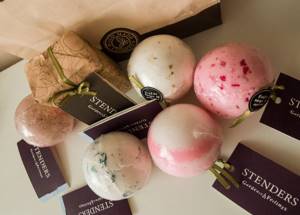
Cosmetics
More about the STENDERS brand
0
How to use bubble bath correctly?
Naturally, every person understands how to make foam in the bath so that the procedure is as pleasant and comfortable as possible, but you just need to know a few rules that will help increase the benefits of such a bath and will never lead to irritation or other undesirable effects.
So, first of all, a proper bubble bath should be taken for 10 to 20 minutes. This period is enough for the skin to absorb all the beneficial substances. If you take a bath longer, then it is quite possible that you will experience irritation from prolonged exposure to aromas, as well as irritation from oversaturation.
After taking a bath, you should not wash yourself from the shower, as many of us are used to doing - with a stream of clean water, you can wash off all the necessary components of the foam, which should remain on the skin and continue to be absorbed. It will be enough to simply dry yourself with a towel.
After taking a bubble bath, it is advisable to relax, lie down, and perhaps even fall asleep, and therefore bubble baths are recommended at night.
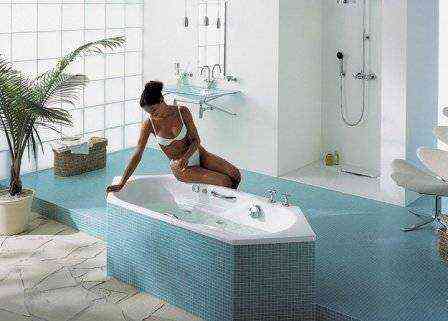
bath foam how to use
I answered my brother what games can be played in the bathroom that are useful for starting speech. It turned out to be a long comment, even if it will be in my diary chronicling the development of Lisa’s speech. There is also a separate folder about the speech development of Dasha’s eldest niece. (Now Dasha is 4 and a half years old, she speaks two languages fluently.)
Bathing a child is a really convenient moment for speech development)
1. because the adult's eyes are very likely at the level of the adult's eyes in this process. This means that the child can clearly see HOW an adult pronounces sounds
2. If you want to swim, you won’t miss it, even with such a love for water as Lisa).
This means it’s not for any benefit for speech development))
There are a lot of SIMPLE words in the bathroom for kids, they can very likely end up in the active dictionary. Moreover, during the bathing process emotions run high.
A simple word + a strong emotion + repeated repetition in “different sauces” is one of the formulas for a child to assign a new word (see the link for a post on why emotionality is so important in a parent’s speech)
Simple words
-
in large letters showed in what form the child can soon name this word:
KAP
- this is water dripping
BUL
— something fell into the water. (how does a duck fall? Bool!; how does a ball fall? Bool! - here, throwing various toys into the water, in parallel with the repeated “bool” we also repeat the name of the toys. This is more fun than just naming them)
PENA —
You can use foam to draw on the wall, for example, a hare. “... one ear... the other ear... and where is Lisa’s ear?) ... and the other... Yes! and Lisa has ears! and the bunny has ears!! and dad... has one ear, yes).. and the other? Yes! ...and Lisa has ears! and the hare... and DADDY!!))
+++
We used foam to make tassels on Katya’s head like a squirrel’s. She then asked to show her in the mirror. “Katya is a squirrel!”, we said, and quite early on she called the squirrel “be”, and then “beka”. During the bathing process you ask: “Are we making a squirrel?”
yeah _
(may sound like “dya” to a baby, less likely “va”))
*** You pour water from some container with the pure saying “YES-YES-YES, it’s over in…. YES!"
- Where is the water?... Ma!... (you still don’t use this “ Ma”
with arms spread out to mean “there is nothing”, but in vain!!!
A very useful and simple word, which then helps to build dialogues and bring other words into speech.
Either this “ma”, or something else “ma” )), a very convenient word for games.
I was surprised recently when I heard this “ma” in a demonstration of games by an Italian speech therapist. She also used it to mean “no something”!)
You can
drown colored lids and balls in water:
You hold them at the bottom and shout “Craaaaaaaaaaaaaaaaayyyyyyyyyyyyy!.. Where are you?” You call like that, as if the red one is really very far away, and you already really miss him)).
You can also say “red” (in the sense of a cork, a lid, but in the feminine gender this address does not have such a beautiful rhythm. I suggest talking about the red COLOR or the color for which you have lids)
When you let go, the lid jumps to the surface: “and wow…….red!” - so can the word “inO”
appear, especially if the parent points each time to the object that jumped out. The word will appear in combination with a pointing gesture.
If I remember or come up with anything else, I’ll add it later. There are definitely more than 4 simple words in the bathroom.
LEI!
- another very useful word. Fill up a small bottle of water and invite Lisa to pour it out
useful, p.ch.:
- one of the few simple first visual verbs,
- short word
- it’s nice to fulfill this request
- and the usefulness of the soft sound “l”, so that the child learns to pronounce it, and does not skip it or replace it with other sounds. Later, a hard “L” will grow out of it, and even later an “R”, but L-R is still VERY soon)) In the meantime, we are preparing, a soft “L” is quite possible to pronounce at one and a half years old.
To begin with, you yourself say “lei” to Lisa. And after a few baths, you can take the bottle yourself and ask “Lisa, what should daddy do?”... Let Olya help you and instead of Lisa answer “Lei!” for a while
***
You can take 2 spoons and a ladle with you to the bathroom. Don't give Lisa everything at once. Keep it down by the bathtub. You give her spoons one by one, offering to fill some container.
“Lei!….. Small spoon…. big spoon.....and HUGE!)
this is a small step towards the emergence of adjectives. Styopa quickly switched to the words “ ma”, “ba”
and "
wow
!"
And in the dictionaries of the mothers with whom we worked to launch their babies’ speech, “ma” and “ba” very often appear in the first 30 words.
***
The foam can be placed on plates, it will be
porridge,
and then fed to the rubber animals. “Yum-yum,” Lisa is already saying. This simplifies the task when, through playing with an already familiar word, we remember a new word. It’s easier for the brain to latch on to it with associative connections and retain it in memory.
***
You can buy
a funnel for bulk products
. Pour water onto the child's hand through a funnel. + to other parts of the body for the parent and child to repeat their names and feel the sensations from these parts of the body. We also use the verb “lei”.
Then turn to the child with the offer “pour foam!” and with it, BE STRONGLY SURPRISED ( also a very favorite emotion for children),
that the foam does not flow.
"What's happened??? the foam doesn’t listen... Pour water!!! .. Hooray! ...Leave foam?...now wateraaaaaaaaaaaaaaaaaaaaaaaaaaaaaaaaaaaaaaaaaaaaaaaaaaaaaaaaaaaaaaaaaaaaaaaaaaaaaaaaaaaaaaaaaaaaaaaaaaaaaaaaaaaaaaaaaaaaaaaaaaaaaaaaaaaaaaaaaaaaaaaaaaaaaaaaaaaaaaaaaaaaaaaaaaaaaaaaaaaaaaaaaaaaaaaaaaaaaaaaaaaaaaaaaaaaaaaaaaaaaaaaaaaaa.
Contraindications for bubble baths
A huge number of beneficial properties of foam baths also imply the presence of negative ones, that is, there are some contraindications:
A foam bath should be warm, but not hot, since a hot bath itself has a bad effect on a person’s general condition, and the aromas become much stronger, sometimes even clogging the breath; Foam with mint or eucalyptus extract is contraindicated for people who suffer from heart disorders; Strong or chemical extracts, dyes, fragrances can cause discomfort, itching, pain and even flaking, so be careful when choosing bath foam.
It is definitely worth remembering that high-quality and truly useful bath foam cannot be cheap. If you have opted for an inexpensive bath foam, try to convince yourself not to purchase such a product.
Contraindications for taking foam baths
Despite all the positive properties of foam baths, there are also contraindications. Bubble baths with eucalyptus and peppermint extracts should not be used by people with heart disease. Those who suffer from allergies need to be very careful when choosing bath foam. Such people are recommended to use bath foam, which contains natural products without synthetic foaming agents.
When purchasing bath foam, carefully study its composition. Many foams contain flavors, dyes, and fragrances that penetrate the skin and can cause discomfort, itching, and pain in the eyes. The smell of the foaming product should be pleasant and gentle. The price of a good quality bubble bath should not be too low. There should not be a lot of foaming agent.
Treat yourself with love and care. Remember that the right bath foam will give you a healing massage and aromatherapy session. Your skin will smooth out, become elastic and velvety. Fatigue and irritation will go away, metabolism will improve, and the body will receive a charge of vigor and health.
DIY bubble bath
In addition to the fact that bath foam can be purchased in a store, from cosmetics promoters or even pharmacy representatives, you can also make it yourself. We took some time and found for you some really cool recipes for making your own bubble bath, which we would like to introduce you to.
Relaxing bubble bath (take before bed)
100 ml liquid glycerin; 100 g castile soap; 5-6 drops of lavender oil; 3-4 drops of patchouli oil.
All foam components should be carefully mixed in one liter of distilled water and slowly added to the bath - 180-250 liters of warm water, under water pressure.
Therapeutic bath foam (for colds)
2-3 drops each of spearmint and peppermint oils; 5-6 drops of eucalyptus oil; 100 g Castile soap; 100 ml liquid glycerin
All ingredients are slowly mixed in a liter of distilled water until smooth and poured into a warm bath, preferably under running water. This bath will help you breathe easier during colds and relax a little before bed.
Romantic bubble bath (based on aphrodisiacs)
2-3 drops of rose oil; 5-6 drops each of jasmine and ylang-ylang oil; 100 ml liquid glycerin; 100 g Castile soap; 2-3 drops of vanilla oil.
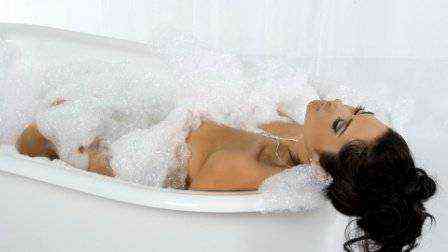
The ingredients are mixed in a container with the addition of one liter of distilled water, then poured into a warm bath, which is taken for a bright, cheerful and romantic mood.
Bath foam is a great way to have fun , feel at the same time a pleasant aroma, relaxation after a hard day and healthy skin, and therefore, feel free to use bath foams, but only high-quality and proven ones.
Instructions on how to make bubble bath
Of course, many people don’t even think about making foam themselves, because it can be bought ready-made. However, its quality often leaves much to be desired. It turns out not so thick and fluffy, it quickly dissolves in water. But you want its aroma and structure to retain their original qualities for a long time. Therefore, it is better to do it yourself. Moreover, making your own foam will delight you for a long time, and the washing procedure with it will be simply pure bliss.
Material
Before you start creating foam, it is worth finding out what material it should be made from, or rather, what tools will be required to create it. To make a foam composition, you can use the following products:
ready-made foam - in many detergent stores you can find special formulations with a liquid consistency. Ready-made compositions can have different colors and aromas. Mixtures with pine, sea, herbaceous, citrus, and fruit aromas are in great demand; bombs are special balls that resemble small balls. They consist of a dry composition, which, when dropped into water, begins to hiss and quickly dissolve, but at the same time it will create the effect of a jacuzzi. The whirlpool effect is created by containing a small amount of sodium bicarbonate and citric acid. They also contain special aromatic additives; sea salt with foam - the use of combined mixtures allows you to create not only a foamy surface of the water when washing, but also create maximum relaxation for the whole body; shampoo and shower gel - you can use regular shampoo or shower gel in making. Thanks to this component, you can create a durable, lush base.
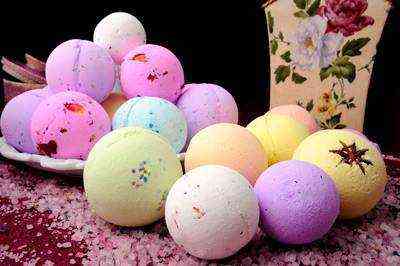
Bombs

Shower gel
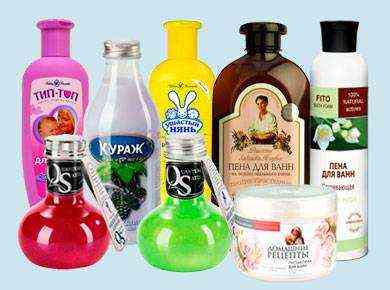
Bath foam
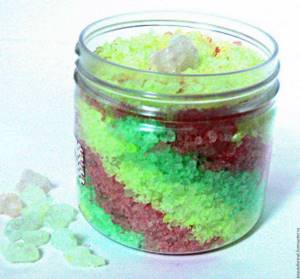
Sea salt with foam
Soap base
You can use regular soap as a base. It can be of different types; this will not deteriorate the quality of the composition.
Features of using soap:
if solid soap is used to make the composition, then one piece per 120 grams will be enough; You can replace soap with simple shampoo. Determine the amount by eye, about ¼ cup will be enough; You can use liquid soap with different scents. The amount of this product depends on how much foam you plan to make.
The base is prepared, it needs to be dissolved in water. Shampoo or soap needs to be mixed with water, about 1 liter of water will be enough. If you use hard soap, you should wait until it completely dissolves.
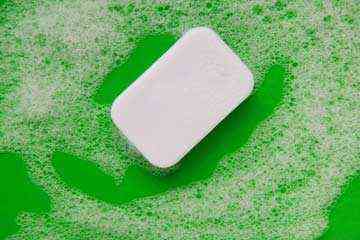
Foam can be made from regular soap
Creating bubbles in foam
To ensure a foamy composition with bubbles, glycerin or coconut oil should be added to it. The difference is that coconut oil has a scent, while glycerin does not.
Glycerin can be found in any pharmacy. And coconut oil is available in health food stores. Glycerin is cheaper in price, and it also moisturizes the skin. If desired, these products can be mixed together.
Features of these components:
by adding glycerin or coconut oil, the foam will have increased durability and a fluffy structure; keeping these products in the foam will ensure the formation of bubbles; Without the use of these products, the foam will quickly lose its structure and ordinary soapy water will form.
To prepare the foam composition, you need to mix 60 grams of glycerin and 30 grams of coconut oil. You can use the opposite dosage of these components - 60 grams of oil and 30 grams of glycerin, but in this case the composition will have a pronounced aroma of coconut oil.
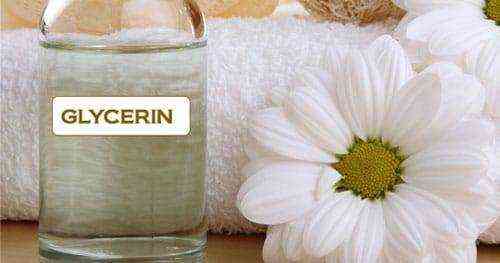
Glycerol
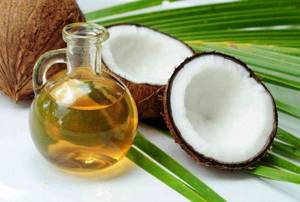
Coconut oil
Adding flavor
An important quality of homemade foam is its aroma. It is this quality that provides rest and relaxation while washing. Almost everyone creates homemade foam for the sake of aroma.
To add aroma, you can use two means:
perfume - just add a few drops of perfume so that the aroma fills the entire room. But you shouldn’t add too much perfume, otherwise your head may hurt; essential oils - these natural products allow you to create a wonderful aroma of foam. In order to create a tropical aroma, you need to add 10 drops of two essential oils - 5 drops of jasmine oil and 5 drops of rose oil. Essential oils
Recipes and methods
So how do you make a lot of foam? In this case, you should use detailed recipes for preparing it yourself. From examples and recipes you can learn how this can be done quickly and easily.
From solid soap
How to make foam from solid soap? Everything is very simple, let’s look at the preparation diagram:
a soap solution is prepared - a piece of solid soap must be rubbed with a grater. Dissolve the resulting shavings in water in a ratio of 1:8 - one part soap and 8 parts water. Be sure to wait until all the pieces of soap have dispersed; 100 grams of glycerin is added to the prepared soap solution; it can be combined with coconut oil; if desired, you can add various products to the mixture that have a positive effect on the skin - herbal mixtures, honey, milk, chocolate; Next, add a few drops of essential oils to give the foam mixture an aroma. To add scent, you can add 10 drops of two types of oils. Below in the table you can see the description and types of essential oils.
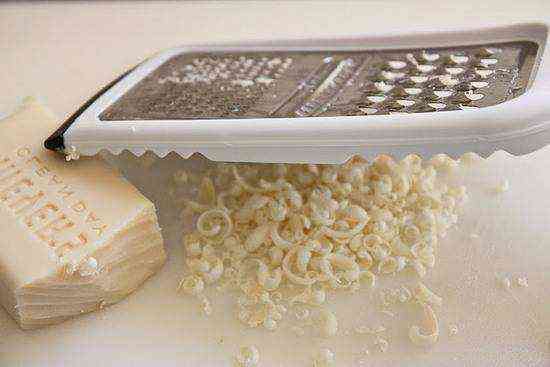
To obtain the base, you need to grate the soap and dissolve it in water.
| Essential oil | Description |
| Apricot | The base of this oil strengthens the structure of nails, skin, and hair. Accelerates the healing of cracks, burns, wounds. Smoothes out wrinkles. |
| Grape seed oil | The use of this type of essential oil gives the skin elasticity and smoothness. |
| Wheat germ oil | Provides prevention for diseases of the cardiovascular system, improves skin structure, and slows down aging. |
| Almond oil | Improves hair structure, makes it beautiful, strong, shiny |
| Pumpkin oil | It has a positive effect on the functioning of the gastrointestinal tract, normalizes the functioning of the liver, kidneys, and eyes. |
From shampoo with glycerin
For shampoo-based foam you need to prepare the following components:
100 ml shampoo; water - 250 ml; 100 ml glycerin; 5 drops of any essential oil.
Let's start cooking:
You need to pour water and shampoo into the pan; mix water with shampoo, but do not raise foam; add glycerin and a few drops of essential oil; the resulting mixture can be poured into a regular plastic bottle; it should be sealed tightly.
The solution should be stored in a dark place. For a bath, it will be enough to pour about 50-60 ml of this solution.
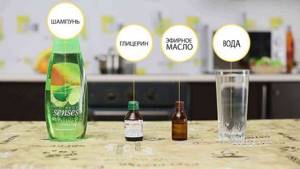
Baby foam
Many children like to have a lot of foam in the bath while bathing. In this case, you can use ready-made formulas for children. Moreover, now there are many types of baby foams on sale that have a thick and fluffy consistency. The smell of these products can be different - fruity, floral, berry.
You can also make baby foam yourself. For preparation, you can use a standard set of components:
baby shampoo – 100 grams; glycerin – 100 grams; water - glass; essential oils optional – 4-5 drops.
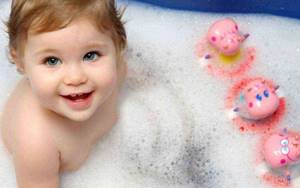
How to make baby foam:
Pour water into a small container and add shampoo; all ingredients are mixed; then add glycerin, you can add a few drops of essential oil; everything is mixed and used for its intended purpose.
Do-it-yourself bubble bath will help make your vacation much more enjoyable, because you can make it yourself. At the same time, it will turn out thick, persistent and fluffy. The main thing is that you need to have all the necessary components and follow the instructions in the recipe exactly.
